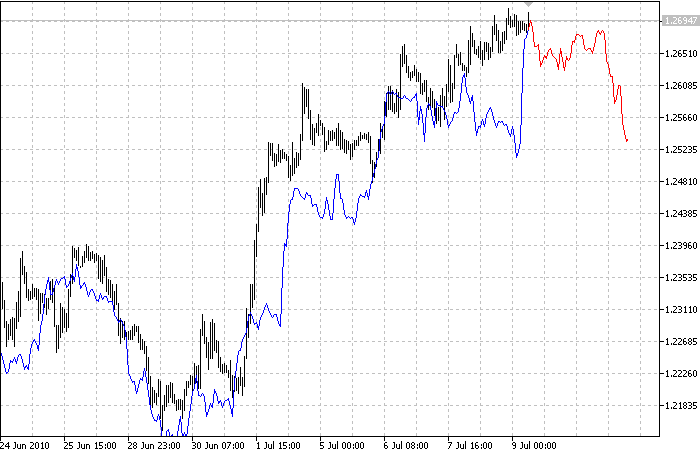Fan sayfamıza katılın
Öyleyse bir link gönderin -
başkalarının da faydalanmasını sağlayın
- Yayınlayan:
- Vladimir
- Görüntülemeler:
- 82
- Derecelendirme:
- Yayınlandı:
- 2025.06.06 11:53
-
Bu koda dayalı bir robota veya göstergeye mi ihtiyacınız var? Freelance üzerinden sipariş edin Freelance'e git
k-En Yakın Komşu algoritması (k-NN), mevcut modele en çok benzeyen k adet geçmiş modeli (komşu) arar ve bu komşuların ağırlıklı oylamasına dayalı olarak gelecekteki fiyatları hesaplar. Mevcut gösterge yalnızca bir en yakın komşu bulur. Yani, özünde, bu bir 1-NN algoritmasıdır. Aralarındaki mesafenin ölçüsü olarak mevcut desen ile tüm geçmiş desenler arasındaki Pearson korelasyon katsayısını kullanır.
Gösterge aşağıdaki giriş parametrelerine sahiptir:
- Npast - bir formasyondaki geçmiş çubukların sayısı;
- Nfut - bir formasyondaki gelecek çubukların sayısı (< Npast olmalıdır).
Gösterge iki eğri çizer: mavi eğri en yakın komşunun geçmiş fiyatlarını gösterir ve kırmızı eğri aynı formasyonun gelecekteki fiyatlarını gösterir. En yakın komşu, bu formasyon ile mevcut formasyon arasındaki doğrusal regresyon eğimine göre ölçeklendirilir. Gösterge ayrıca en yakın komşunun başlangıç tarihi ve mevcut desenle korelasyon katsayısı hakkındaki bilgileri de yazdırır. Örneğin,
Nearest_Neighbor (EURUSD,H1): En yakın komşu 2003.08.26 23:00:00 tarihlidir ve mevcut formasyon ile 0.9432442047577905 korelasyona sahiptir;
Resim:

MetaQuotes Ltd tarafından İngilizceden çevrilmiştir.
Orijinal kod: https://www.mql5.com/en/code/133
 iS7N_TREND_1
iS7N_TREND_1
Tek renkli iken basit yumuşatma algoritmalarına sahip trend göstergesi.
 Zamanlayıcı
Zamanlayıcı
Zamanlayıcı için geri arama arayüzü
 Price prediction by Nearest Neighbor found by a weighted correlation coefficient
Price prediction by Nearest Neighbor found by a weighted correlation coefficient
Bu gösterge, daha yeni fiyatların daha büyük ağırlığa sahip olduğu ağırlıklı bir korelasyon katsayısı kullanarak en yakın komşuyu bulur. Ağırlık, bir fiyat modeli içinde daha yeni fiyatlardan daha eski fiyatlara doğru doğrusal olarak azalır.
 Creating a Simple News Filter for XAUUSD Trading on MT5
Creating a Simple News Filter for XAUUSD Trading on MT5
XAUUSD (Altın) ticareti genellikle USD, GBP veya EUR bültenleri gibi önemli ekonomik haber olaylarından etkilenir. Bu değişken dönemlerde riskleri azaltmak için Uzman Danışmanınızda (EA) bir Haber Filtresi kullanmak çok önemlidir. Bu makalede, MT5'te basit bir Haber Filtresinin nasıl oluşturulacağını ve XAUUSD ticaretine nasıl uygulanacağını paylaşacağım.